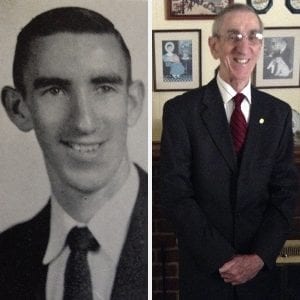 Temp Sparkman
Temp SparkmanTemp Sparkman, a student from the first graduating class of Belmont College, talks about how Belmont Athletic teams came to be the Bruins and the University first got accredited.
Click here to read his story on the Bruins.
Click here to read his story on Accreditation.
Temp Sparkman
Class of 1955 (first graduating class of Belmont College)
Psychology major with education minor
Retired Academic, Ed.D.
Becoming the Bruins
In early 1993, I left my home in Kansas City to go downtown to the Kemper Arena to see Belmont play in a small college tournament. Upon entering the playing arena, I saw some familiar faces in the Belmont section. Belmont President William Troutt hailed me down and invited me to sit with him. He introduced me as Belmont’s first basketball captain in 1952. As the game wore on, I began to think about the Belmont mascot “Rebels,” which was the team’s name back then. After the first team was formed, Coach Larry Striplin called a team meeting to choose a mascot. In an early sports story in the Nashville papers about us, we were referred to as the “Gents,” the name he preferred. I presided over the session, asking for nominations. After “Gents” and other names were mentioned, Forrest King suggested that we should be the “Rebels.” That won the day.
But in the 1993 conversation, I quietly said to the president, “Someone’s going to have to muster the courage to consign the tag to history. It is not fair to the players or representative of the school’s character.”
A few weeks later, Troutt wrote asking me to put my suggestion and sentiments in a letter. He talked with many others about it, and then asked them to express their support of a change. In my letter, I repeated the judgement I’d made about the name in my conversation with Troutt at the tournament game. In my response, in keeping with my loyalty to Belmont since 1951, “…I want to encourage the establishment of a process by which the university reconsiders the names of its athletic teams.” I suggested that a different name would be fairer to the diverse student body now walking Belmont’s historic campus, and be more compatible with the literate faculty in touch with the realities of the new South and global ecologies. “As a Belmont son who wore her colors for three seasons, I know it is painful to consign a tradition to the status of memorabilia, but the name ‘Belmont’ is what matters, and endures.”
Troutt chose the “Bruins,” and announced it at a press conference. So the “Rebels” moniker, adopted in youthful innocence to the Jim Crow era of American society, gave way to the “Bruins.”
Temp Sparkman
Class of 1955 (first graduating class of Belmont College)
Psychology major with education minor
Retired Academic, Ed.D.
Accreditation
In 1951, on south Nashville’s Belmont Boulevard, the institutional saga at the celebrated Belle Monte site took a coeducational turn as a second Belmont College replaced the Ward-Belmont school for women. On a day in mid-September, men shuffled out of historic Heron Hall and women scaled the steps leading up to the street level of the Belmont Circle. These pioneers had gotten acquainted earlier in the week as they helped unload cars and moved into the dorms. The eager students were headed to the library to register for classes. Joined by commuting students, 136 of us (all except 12 from Tennessee), we passed between the Greek Ionic pillars of John Diehl Blanton Hall then went straight into the library. Once there, academic dean Clarence P. Denman introduced us to a curriculum in the classical liberal arts and sciences and in music classes from the prestigious music conservatory inherited from Ward-Belmont, and new courses in religion. Classmate Annette Binkley (now Martin) remembers that we were given index cards to give to teachers waiting at tables to put us on their rolls. Next, we began what students universally do–read and attend classes. Our first formal assembly was on September 14 in the auditorium in North Front Hall overlooking the Nashville skyline. We later attended chapel there every school day.
In 1953, these students were awarded Associate of Arts diplomas under authority of the accredited Ward-Belmont. The four year Belmont, though, was not yet accredited. That matter became the passion of the first president R. Kelly White. I was president of the student body, so we met often.
“Accreditation is a just a matter of time, Temp,” he’d tell me. In December 1959, the coveted status was conferred by The Southern Association of Colleges. In announcing the accomplishment to a stellar gathering of persons from Belmont’s founding, then president Herbert C. Gabhart praised White for his work: “He made clear footprints in that direction.” The accreditors were impressed with Belmont’s evolution in so brief a time of its existence.
In 1991, President William E. Troutt announced a new status for the school–Belmont University. He said that the university would be a teaching school with a College of Arts and Sciences and professional schools. Upon hearing this news, I said to myself, “What a quantum leap from the time when we left our soul-prints in the Belmont Circle.”